If you’re new to content creation and ranking websites, search engine optimization (SEO) can be overwhelming.
There’s so much to learn. And the learning process is sometimes made more challenging by so many acronyms thrown around.
This post will keep things simple. But the results will still be powerful.
Ready to get started?
In This Article
- The Fundamentals You Need to Cover
- On-page SEO Basics
- 5. It All Starts with Keyword Research
- 6. Throw Search Intent Into the Mix
- 7. Use Your Keywords to Design a Solid Content Calendar
- 8. Know Where to Place Your Keywords Strategically
- 9. Create SEO and User-friendly Content?
- 10. Build Strategic Internal Links
- 11. Build Authority with Outbound Links
- 12. Create and Optimize a Sitemap
- Off-page SEO Basics
- Master Technical SEO Basics
- Use this SEO Tutorial to Improve Your Chances of Ranking
The Fundamentals You Need to Cover
Before you can execute an effective SEO campaign, you must first grasp SEO fundamentals. These are essential foundational principles that dictate how you’ll design, implement, and monitor your campaigns.
1. Understand SEO and Why it’s Important
The first step to designing impactful SEO strategies is understanding what SEO is.
What is SEO?
SEO is the process of improving the quantity and quality of organic (not paid-for) traffic that comes to your website. To do this, you must increase the visibility of your content on search engine results pages (SERPs).
For people to see your content, it must be featured on the first page of SERPs. Therefore, the higher your content ranks on SERPs, the better the chances of people finding it. As a result, you’ll enjoy more traffic to your website.
2. Know How Search Engines Function
Knowing how search engines work is another crucial aspect of running effective SEO campaigns.
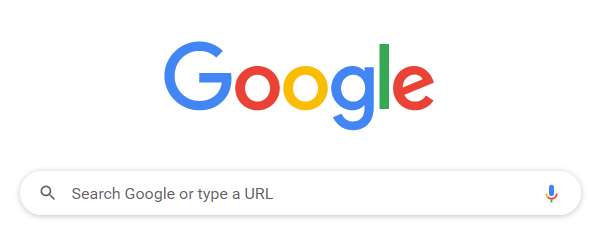
Don’t worry. We’re not going into the technical details here. Instead, we’ll look at two core functions search engines perform that impact SEO — crawling and indexing.
- Crawling: This is when search engines scour the internet for content. The main point of crawling is understanding the content on each website.
- Indexing: After search bots crawl a web page, they store and organize the content in an index repository. Once a page has been indexed, search engines can pull up your URL for relevant searches.
What does this mean for SEO?
It means if search engines can’t crawl or index your content, there’s no way it can rank.
We’ll look at optimizing for indexing in the section on technical SEO.
3. Equip Yourself with the Right SEO Tools
SEO is a data-driven type of digital marketing. As such, it’s virtually impossible to succeed without some SEO tools. Here’s a short list of the basic ones you need:
- Google Search Console (GSC): GSC is a free tool from Google that gives you data on your website’s performance. Some of the insights it gives you include site health, backlinks, insights into search queries, and much more.
- Google Analytics (GA): GA is a user-centric tool from Google that gives you insight into, among other things, your website visitors, where they came from, and what they do on your website.
- AIOSEO: This is a WordPress plugin designed to help with on-page and technical optimization. You can use it to implement schema markup, create sitemaps, optimize metadata, competitor analysis, and much more.
- Semrush: Semrush is an all-in-one digital marketing tool you can use as a keyword research tool, SERP tracker, site health checker, traffic analytics tool, and more.
- Ahrefs: Like Semrush, Ahrefs is an all-in-one tool with powerful functionalities. These include, among others, a backlink checker, competitor analysis, rank tracking, site audits, e.t.c.
Armed with the right tools, getting the right data and designing effective SEO campaigns becomes easier.
4. Conduct Audience Research
To drive relevant and targeted traffic to your site, you need to create content your audience finds valuable and helpful.
That’s why you must invest in audience research.
Audience research will give you insights into:
- Demographic data: Demographics are the physical attributes that make up your audience’s profile. These are attributes like age, location, income bracket, and more.
- Psychographic data: Psychographics are the psychological traits that influence your customers’ behavior. Examples include values, goals, opinions, beliefs, lifestyles, e.t.c.
Knowing your audience is essential to creating content and campaigns that resonate with them. This will lead to your content not just ranking high but converting well too.
On-page SEO Basics
Once you’ve got the fundamentals out of the way, the next step to getting a handle on SEO is mastering the on-page SEO basics.
FYI, on-page SEO deals with elements on your website you can manipulate for better search rankings. Here are some of the most important ones:
5. It All Starts with Keyword Research
On-page SEO starts with keyword research. This is the process of discovering the words and phrases users input into search engines when looking for information.
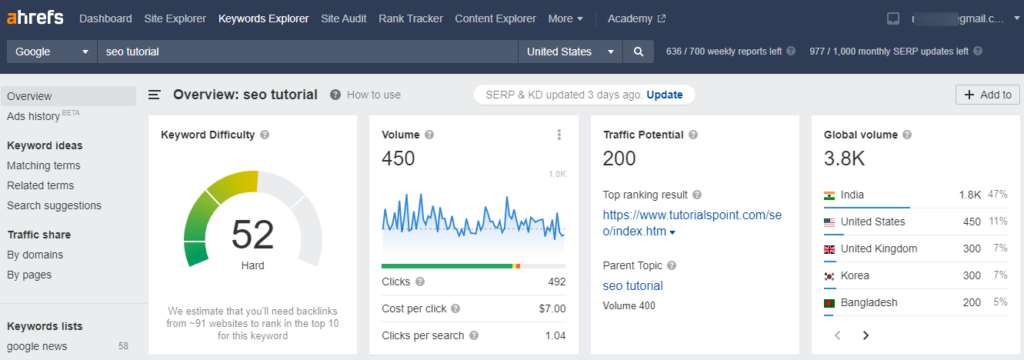
Keyword research is an invaluable tool as it gives you insight into what your target audience is looking for. This, in turn, will help you create content that answers their questions. Keyword-focused content gives you a better opportunity to rank on SERPs. It also enables you to gain the trust of users.
A few tips for effective keyword research include:
- Brainstorm topics you want to rank for
- Create topic buckets
- Use keyword research tools to find seed keywords for each topic bucket
- Check out your competitors, particularly the keywords they are ranking for
Once you’ve discovered potential keywords, use your keyword research tool to analyze and vet them. Check for factors like keyword difficulty, search volume, and search trends, among others.
6. Throw Search Intent Into the Mix
Once you’ve found your keywords, you can go ahead and start creating content, right?
Not quite.
Keywords alone won’t help you rank. You must also understand the intent behind those keywords.
This is called search intent, and it can be categorized into:
- Informational: This is when a user is looking for general information about a topic.
- Navigational: Displayed when a user wants to go to a particular website or page.
- Commercial: This is when a user is researching a product and intends to buy it soon.
- Transactional: Searchers with this type of intent usually search with the purpose of buying something at that moment.
Knowing the reason behind a search query is important as it will help you create content that your audience wants to read. This will result in higher conversion rates, increased dwell time, and ultimately, more revenue generated for your business.
To discover the intent behind a keyword, plug it into a search engine and observe the top-ranking articles. You can also get intent data from tools like GSC and Semrush, among others.
7. Use Your Keywords to Design a Solid Content Calendar
Armed with your keywords, you can now start planning your content creation. The first place to start is to create a content calendar. A content calendar is a living document that helps you plan out your content in advance. A few benefits of a content calendar include:
- Keeps your content team organized and on track
- Enhances accountability as everyone knows what to do and when to do it
- Helps you sustain your audience’s interest by keeping your content aligned with search intent
- Keeps your content team organized
- Makes it easy to track performance
Planning your content will help you focus on content pieces that will give you the most traction.
8. Know Where to Place Your Keywords Strategically
After short-listing your keywords and understanding the searcher intent behind them, the next step is to know where to place them. Some of the most important include:
- Headline
- Header tags
- Introduction and conclusion
- Image alt tags
- Meta description
- SEO title
- Body copy
Proper keyword placement is a critical component of creating content that’s optimized to rank. However, you must be careful that you don’t overuse your keyword as search engines will consider this keyword stuffing. Instead, consider using variants of your keyword wherever possible.
9. Create SEO and User-friendly Content?
The final step in mastering on-page SEO is creating user-friendly content that’s also optimized for search engines. Here’s what that kind of content looks like:
Lots of Subheads
Avoid walls of text by breaking up your text with many subheads. This makes it easy for users to skim through your content. Using many subheads also makes it easy for search engines to figure out the topical relevance of your content.
Easy to Read
Keep your sentences and paragraphs short. This makes for easy reading and digestion of your content.
Include Lots of Visual Assets
Visual assets are essential elements of your content. They help convey your message better. Also, they help encourage engagement. Whether it’s a GIF, video, or static image, find ways of including them in relevant places in your content. However, make sure your images are SEO-optimized.
10. Build Strategic Internal Links
Internal links are links on your site that point to other pages and posts on your site. These play a vital role in SEO as they help you provide users with a positive experience. This results in increased dwell time, indicating to search engines that visitors find your content valuable. Also, executed well, a good internal linking strategy will help search engines understand which pages are more important on your site.
To build your internal links strategically, you must ensure each page you link out to adds more value to the page you’re linking out from. If you have many pages on your site, this can be quite hard to do.
Thankfully, AIOSEO added a feature called Link Assistant that helps you do this easier and much faster. That’s because Link Assistant looks for other posts on your website relevant to your current post’s focus keyword. Once it finds them, it looks for anchor text it can marry to the different posts you can link to.
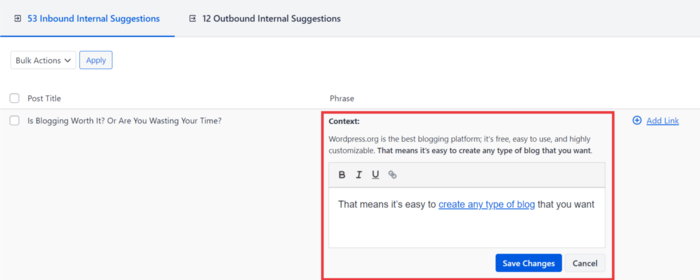
The best part is you can accept all suggestions with a single click. You can also choose to accept the suggestions one at a time and tweak the anchor text you’ll be using.
11. Build Authority with Outbound Links
Search engines want to make sure they only recommend authoritative content. One way of building authority is to cite other publications, facts, and statistics. Linking out to authority sites also helps strengthen the topic signal for that page. This is important as it helps show search engines that your content will meet user intent.
If you’ve already built outbound links on your site, you can use Link Assistant to help optimize them. The tool will show you all the outbound links on a particular page, enabling you to vet which to delete, which to keep, and which anchor text to optimize.
12. Create and Optimize a Sitemap
A sitemap is a blueprint of your website. One of its primary purposes is to help search engines find, crawl, and index all important pages on your website. That’s why you must create and optimize a sitemap for your site.

A couple of ways to do that include:
- Create your sitemap
- Submit your sitemap to Google
- Structure your sitemap by section
- Only include important pages
- Exclude pages that have been redirected or canonicalized
Sound complicated?
Don’t worry. Our mission here at AIOSEO is to make SEO easier for everyone, including those with no technical background. That’s why we included a sitemap generator in our plugin.
You can easily implement the type of sitemap relevant to your website with just a few clicks. The advanced settings also give you more control over the links to be included or excluded in the sitemap.
Off-page SEO Basics
Off-page SEO is more challenging than on-page SEO in that it deals with factors away from your website that can influence your rankings. It involves any activity away from your website that impacts your website’s performance. These activities are deemed a vote of confidence in your site by search engines and, therefore, help determine your ranking.
Here are some activities you can leverage off-site to boost your SEO:
13. Build Relevant Backlinks
Link building is one of the most fundamental off-page SEO practices with high-impact results. That’s why you must invest time and resources in building relevant backlinks. These are links from other sites pointing to your site. For your backlinks to be relevant, they must be from:
- Authoritative sites
- Sites with a similar audience to yours
- Sites that feature content that’s topically relevant to yours
Building backlinks can be a daunting task if you don’t know how to go about it. A few tips to help you build some, even when you don’t have much experience, include:
- Guest posting: This is the practice of publishing content on sites that aren’t your own. When you do this, you can earn a backlink to your site.
- Repair broken links: Find broken links on relevant authority sites and offer them content on your site to repair the broken link.
- Email outreach: Reach out to sites in your niche to offer specific links for content on their site. Make sure your content is of high quality and adds value to the pages you’re targeting.
- Create a free tool: Creating a free tool that helps your audience reach their goals is an excellent way to build links. Publications in your niche are likely to link to it to add value to their content. Here’s an example from our friends at MonsterInsights.
- Publish a unique study/research: Webmasters rely on facts, studies, and research to add value to their content. It helps build authority. That’s why publishing unique studies is an excellent strategy for attracting backlinks.
- Leverage Barnacle SEO: Barnacle SEO is the practice of getting your site listed on big sites in your niche. A great example is getting listed on review sites, business directories, or partner pages on large sites.
- Participate in roundup posts: These are posts where experts share their views on a hot topic. Apart from helping you build backlinks, this also has the advantages of giving you more visibility and driving more traffic to your site.
14. Drive Brand Signals
An underrated off-page SEO strategy you must leverage to improve your rankings is generating brand signals.
Brand signals are mentions of your brand across the internet. Whether they are linked or not, any positive mentions of your brand help boost your authority.
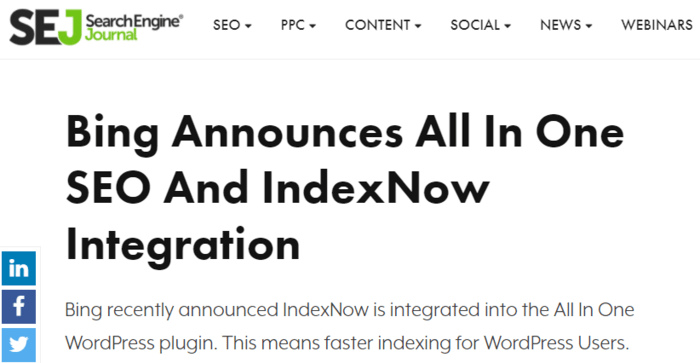
How do you drive brand signals?
- Invest in a robust social media strategy
- Run PR campaigns
- Encourage your customers to leave positive reviews on third-party platforms
- Do, say, or create something newsworthy
Brand signals are an excellent way of building credibility. This results in search engines valuing your content more, giving you a competitive advantage.
Master Technical SEO Basics
Technical SEO is not as daunting as it sounds. You just need to know what to do.
What is technical SEO?
Technical SEO is the practice of optimizing technical elements of your website and server that impact your website’s performance and user experience. Some aspects to focus on to ensure your technical SEO is on point include:
15. Page Experience
Page experience is one of the primary elements to consider when working on your technical SEO. That’s because it encompasses many other technical SEO aspects that have a high impact on your SEO.
What is page experience?
Page experience refers to a set of signals Google uses to measure how users perceive the experience they have when interacting with your web pages. These signals include:
- Core web vitals: Core web vitals deal with site speed, interactivity, and a page’s stability. These three elements have a massive influence on the experience factor on your website.
- Mobile-friendliness: Search engines prioritize websites that focus on a mobile-first experience as 54.98% of searches are performed on mobile.
- Security: Implementing HTTPS is a signal that your website is safe. Therefore, search engines will promote your content above sites that are still on HTTP (a less secure protocol).
- Intrusive interstitial elements: An intrusive interstitial is any element on a web page that covers a large percentage of the content on a web page, thereby making it difficult to access.
With search engines taking user experience (UX) into account as a ranking factor, nailing your page experience is a no-brainer. It should be a priority when optimizing the technical aspects of your website.
16. Check for Crawl Errors
Crawl errors hinder websites from reaching important pages on your website. That’s why you must regularly check for them on your website. Some common factors that can lead to crawl errors include:
- Broken links
- 404 errors
- Redirect chains and loops
- DNS errors
- Server errors
- Wrongly formatted robots.txt file
Remember, if search engines can’t crawl pages on your site, those pages can’t rank. Crawl errors can also send a signal to search engines that your site is of low quality.
17. Site Architecture
Site architecture refers to how you organize, group, and link pages on your website. Your site architecture can help users and search engines easily find what they are looking for. This can lead to increased time on site, signaling to search engines that your site offers a positive UX and valuable content.
To optimize your site architecture, you must factor in:
- Navigation menus
- Categorization
- URL structures
- Breadcrumbs
- Internal linking
Remember, search engines are all about providing users with a positive UX.
18. Use Search Engine-friendly URLs
URL structure plays a vital role in technical SEO. For one, URLs tell search engines and users what a page is about. Because of that, your URL structure must be:
- Logical
- Short and descriptive
- Easy to read
- Intelligible to readers
Your URLs should also help show readers that your content will meet their search intent. To do this, include your keyword. If you’re a WordPress user, avoid using the default URL WordPress assigns to a post. Instead, edit it to make it SEO-friendly. You can easily do this using AIOSEO.
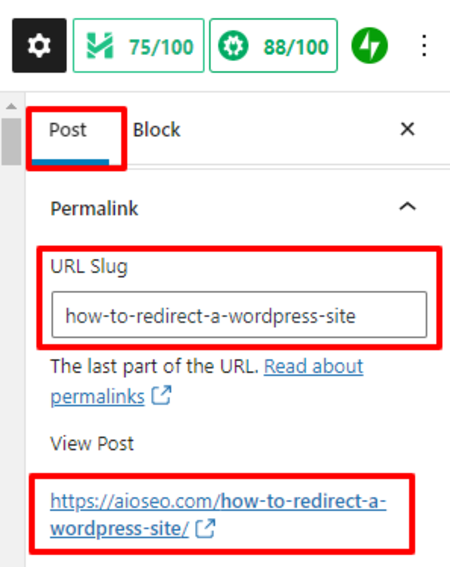
Besides the tips above, make sure to future-proof your URLs. One way of doing this is avoiding including dates or numbers in the URL, even if they may appear in the headline.
For more technical SEO tips, check out our technical SEO checklist.
Use this SEO Tutorial to Improve Your Chances of Ranking
As a beginner, SEO may seem like a daunting task. But once you cover the basics, you’ll discover that you can create SEO strategies that will help you drive a ton of traffic to your site.
Remember, one of the best tools you can use to optimize a WordPress site is AIOSEO. With AIOSEO, you can easily implement most of these steps with just a few clicks of a button. That’s why, if you haven’t yet, you should download the AIOSEO plugin today. It will help you rank your content without having to hire an expert.
Disclosure: Our content is reader-supported. This means if you click on some of our links, then we may earn a commission. We only recommend products that we believe will add value to our readers.


Useful information, well written.
Lo usamos muy bien
Can you provide this content in hindi?
It will be more helpful for understand the content